This is a list of flags used in the modern state of Greece or historically used by Greeks.
National flag
| Flag | Date | Use | Description |
|---|---|---|---|
 |
In use since 1822 (as the Greek naval ensign), and from 1978 onwards as the sole National Flag. | The current Flag of Greece was adopted by the First National Assembly at Epidaurus in January 1822 as the official naval ensign of the country.
Between 1822 and 1978, this flag was flown on Greek vessels and also used for foreign service. In 1978, it was established as the sole National Flag of Greece, and as the war and civil Ensign, and has been used in that capacity ever since. |
Nine horizontal stripes of equal width; five blue alternating with four white. Number nine stands for the syllables of the National Motto of Greece. Blue canton (rectangle in the upper hoist-side corner of the flag) of square shape, five stripes wide, bearing a white Greek cross at its center, with the arms of the cross being one stripe wide. Canton and stripe elements combined properly, in a harmonious and complementary fashion. Flag ratio is 2:3 and color shade is traditionally intermediate, neither light, nor dark, although its precise shade is not officially stipulated by law. |

|
Same as above. Particular shade of blue introduced in 1970. | Same as above. | Variant of the Greek National Flag in 2:3 aspect ratio and in a "midnight blue" shade. Although legally valid and fully equivalent to the version depicted above, flag variants in darker shades of blue are reminiscent of the flag used between 1970 and 1975 as introduced by the Regime of the Colonels, albeit in a 7:12 rather than a 2:3 aspect ratio for the duration of that time period. |
Presidential standard
| Flag | Date | Use | Description |
|---|---|---|---|
 |
since 1979 | Distinguishing flag of the president of the Hellenic Republic (president of Greece). Used to show the presence of the President of the Republic (in vehicles, buildings etc.). This flag also used as a Rank flag in the Hellenic Navy's ships mainmast when the President of the Republic is aboard (according to Article 45 of the Greek Constitution, the President of the Republic is the head of the Armed Forces, so as Rank flag this flag is regarded as equivalent to the flag of an Admiral of the Fleet or superior). | Square flag bearing the coat of arms of Greece.
A square field of blue color, with an escutcheon encircled by a golden laurel wreath (consisting of two laurel branches) placed at its center. An escutcheon of French 17th Century Style; (near square with rounded lower corners and a gentle tip at its bottom middle) its color azure; (blue of a shade identical to that of the field surrounding it) its border line golden, continuous, discreet; bearing a Greek Cross argent (cross with arms of equal length and of white color) at its center. Cross formed thus: regular perpendicular lines perform 3x3 division of the escutcheon surface area; corner squares azure; all others argent. In short, Greek Cross argent, escutcheon azure, laurel wreath or, field azure. (items centralized) The standard is usually produced in four sizes (1st 1.70 m (5.58 ft) sides, 2nd 1.10 m (3.61 ft) sides, 3d 0.65 m (2.13 ft) sides and 4th 0.23 m (0.75 ft) sides). |
 |
1973–1974 | Presidential flag during the republican phase of the Regime of the Colonels (June 1973 - July 1974). | A golden phoenix rising from the flames on a dark "midnight blue" background. |
 |
1924–1935 | Presidential flag during the Second Hellenic Republic. | White cross on azure field. |
Royal standards
| Flag | Date | Use | Description |
|---|---|---|---|
 |
1936–1974 | Royal standard of the king, adopted in 1936. | Like the Navy jack, with the royal family arms in the centre and four crowns in the quarters. |
 |
1936–1974 | Standard of the crown prince, adopted in 1936. | Like the Navy jack, with the Greek royal family arms in the centre and one crown in the first quarter. |
 |
1936–1974 | Standard used by the Greek royal family, adopted in 1936. | Like the Navy jack, with the Greek royal family arms in the centre but no crown. |

|
1963-1964 | Personal flag of Queen Frederica of Greece. | |
 |
1914–1924 1935–1936 |
Standard used by the crown prince, adopted in 1914. The flag was made redundant after the abolition of the monarchy in 1924. Following the restoration of the monarchy in 1935, the 1914 decrees regarding Greek flags and those of the royal family were reinstated by decree of 7 November 1935. This flag was replaced in 1936 with a new design. | Like the Navy jack, but in a light blue field. In the first and third quarter is a royal crown. |
 |
1914–1924 1935–1936 |
Standard of the queen of Greece (in this case, showing the arms of Sophia of Prussia), adopted in 1914. The flag was made redundant after the abolition of the monarchy in 1924. Following the restoration of the monarchy in 1935, the 1914 decrees regarding Greek flags and those of the royal family were reinstated by decree of 7 November 1935. | |
 |
1914–1924 1935–1936 |
Standard used by the other members of the royal family, adopted in 1914. The flag was made redundant after the abolition of the monarchy in 1924. Following the restoration of the monarchy in 1935, the 1914 decrees regarding Greek flags and those of the royal family were reinstated by decree of 7 November 1935. | |
 |
1914–1917, 1920–1922 | Royal standard of the king, adopted in 1914. The crossed marshal's batons refer to King Constantine I, who was raised to the rank in 1913. The flag was in use during Constantine I's two reigns, 1913–1917 and 1920–1922. | Like the Navy jack, but in a light blue field with the Arms of King Constantine I at the center. Behind the arms are two crossed Field Marshal's batons. |

|
1913–1914 | Personal flag of Queen Olga of Greece as Queen Mother, as specified in the Royal Decree of 3 June 1914 | |
 |
1863–1913 | Standard used by King George I of Greece. | The flag consists of the plain cross version of the national flag, with a royal coat of arms of Greece superimposed in the center of the cross. |
 |
1863–1913 | Royal standard reported during the early years of King George I's reign. | Swallow-tailed Greek flag and the coat of arms of House of Glücksburg. |
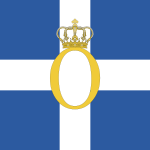 |
1832–1862 | Royal standard during reign of King Otto. | The flag consists of a square plain cross version of the flag with the monogram of King Otto of Greece in the middle. |
 |
1858–1862 | Royal standard for use on ships during the late reign of King Otto, adopted in 1858. | The flag consists of the plain cross version of the national flag in 3:2 proportions, with the Bavarian arms of the Wittelsbach dynasty superimposed in the center of the cross, topped by a crown. The blue color is of a lighter shade than usual today. |
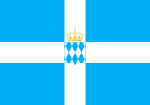 |
1833–1858 | Royal standard for use on ships during most of the reign of King Otto, adopted in 1833. | The flag consists of the plain cross version of the national flag in 10:7 proportions, with the Bavarian arms of the Wittelsbach dynasty superimposed in the center of the cross, topped by a crown. The blue color is of a lighter shade than usual today. |
Military flags
Hellenic Armed Forces
| Flag | Date | Use | Description |
|---|---|---|---|

|
1950–Present | Flag of the Hellenic National Defence General Staff. | |

|
1950–Present | Rank flag of the Chief of the Hellenic National Defence General Staff - Army variant. | |

|
1950–Present | Rank flag of the Chief of the Hellenic National Defence General Staff - Navy variant. | |

|
1950–Present | Rank flag of the Chief of the Hellenic National Defence General Staff - Air force variant. |
Hellenic Army
| Flag | Date | Use | Description |
|---|---|---|---|
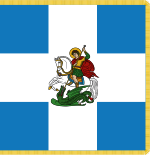
|
Army War Flag (regimental colour) (Πολεμική Σημαία Στρατού Ξηράς) | A square flag with a white cross on blue field with an image of Saint George slaying the dragon. | |
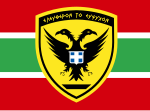
|
1904–present | Flag of the Hellenic Army General Staff. | The seal of the Hellenic Army on three stripes red, green and red with white borders in-between. |

|
?-Present | Hellenic Army General flag. | |

|
?-Present | Hellenic Army Major General flag. | |

|
?-Present | Hellenic Army Lieutenant General flag. | |

|
?-Present | Hellenic Army Brigadier General flag. |
Hellenic Navy
| Flag | Date | Use | Description |
|---|---|---|---|
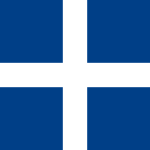 |
1822–Present | Jack of the Hellenic Navy. | A square flag with a white cross on a blue field. A golden crown was added in the centre during the periods of monarchy (1833–1924 and 1935–1973). |
| 1822–Present | Commissioning pennant (Greek: Επισείων Πολεμικού Πλοίου, i.e., "Warship Pennant") flown by all Hellenic Navy's ships and establishments in commission, unless displaced by a senior officer's rank flag. | "Warship pennant, blue coloured, has shape of isosceles triangle elongated, bearing a white cross near the base of the triangle". The flag has typically base to length (height of triangle) 1 to 20. The cross has arms width 1/5 base length and each arm length 3/5 of base length. The pennant flown on the top of mainmast. | |

|
Flag of the Hellenic Navy General Staff. | The Seal of the Hellenic Navy on three stripes white, red and white with a blue outer border. | |

|
Rank flag of the admiral of the Hellenic Navy. | A square flag with a white cross on a blue field with a star in all four quarters. | |
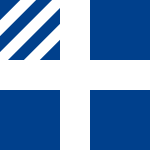 |
1956–Present | Rank flag of the prime minister of Greece aboard Hellenic Navy vessels. | Like the Hellenic Navy jack, with three white rising diagonal stripes in the first quarter. |
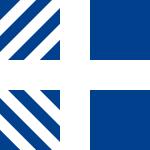 |
1956–Present | Rank flag of the Greek minister of national defence aboard Hellenic Navy vessels. | Like the Hellenic Navy jack, with three white rising diagonal stripes in the first quarter and three descending stripes in the fourth. |

|
1956–Present | Rank flag for ministers of the Hellenic Republic. | Like the Hellenic Navy jack, with three white rising diagonal stripes in the first and the fourth quarter. |
Hellenic Air Force
| Flag | Date | Use | Description |
|---|---|---|---|
| Air Force War Flag (regimental colour) (Πολεμική Σημαία Αεροπορίας) | A square flag with a white cross on a blue field with an image of Archangel Michael in the middle. | ||
| ?-Present | Flag of the Hellenic Air Force General Staff. | The seal of the Hellenic Air Force on three stripes blue, yellow and blue with red borders in-between. | |

|
?-Present | Air Chief Marshal flag. | |

|
?-Present | Air Marshal flag. | |

|
?-Present | Air Vice Marshal flag. | |

|
?-Present | Brigadier of the Air Force flag. |
Hellenic Coast Guard
| Flag | Date | Use | Description |
|---|---|---|---|

|
?-Present | Service flag of the Hellenic Coast Guard. | Seven horizontal stripes, white and blue, with the emblem of the Hellenic Coast Guard. |

|
?-Present | House flag of Hellenic Coast Guard vessels. | Fifteen vertical blue and white stripes with two blue anchors crossed and a white canton in the upper left corner with the national emblem of Greece in the centre. |
Regional and municipal flags
| Flag | Date | Use | Description |
|---|---|---|---|
| Regional Flags | |||
 |
1980–Present | Flag of the region of Macedonia. | Blue field with the golden Vergina Sun in the centre. The flag is unofficial but widely recognized in Greece. |
| Flag of the administrative region of Thessaly. | A blue map of Thessaly surrounded by 12 stars on a white field. | ||

|
Flag of the administrative Region of South Aegean. | The emblem of the Region of South Aegean on a white field. | |

|
Flag of the administrative region of Western Greece. | The emblem of the region of Western Greece on a white field. | |
| Municipal Flags | |||
| Municipal flag of Athens. | The flag is blue with an inner gold and outer red border, like the flag of the region of Attica. A white Greek cross lies in the middle, charged with a disc with a white border featuring gold olive branches. The blue disc in the center features the head of the goddess Athena. | ||
 |
Municipal flag of Thessaloniki. | Dark blue with a stylized depiction of the city's main landmark, the White Tower, and an ancient Macedonian coin depicting Alexander the Great. | |
 |
Municipal flag of Patras. | The seal of the city of Patras on a dark blue background with an outer gold border. | |

|
1896–Present | Municipal flag of Kallithea | |
 |
Municipal flag of Rhodes (city). | The seal of the city of Rhodes, depicting the head of Helios, on a blue gray background. | |
 |
Flag of Corfu island. | The flag of Corfu had a dark red/maroon/purple large outer border, a dark gold thin inner border and a very dark blue field with the seal in the centre in dark gold. The seal shows an ancient Greek Corfiot sailing ship. ΔΗΜΟΣ (Municipality) is written above the seal, ΚΕΡΚΥΡΑΣ (of Corfu), below the seal. The flag, on which the image shown above is based, had a ratio of 11:19. | |
 |
Flag of Zakynthos island. | Dark green with an orange depiction of Zakynthos with the island's motto "Freedom needs virtue and courage" (ΘΕΛΕΙ ΑΡΕΤΗ ΚΑΙ ΤΟΛΜΗ Η ΕΛΕΥΘΕΡΙΑ, from Andreas Kalvos' The Lyre). | |

|
Flag of Aegina island. | ||
 |
1821–Present | The flag of Kastelorizo, used as an ensign for ships from Kastelorizo during the Greek War of Independence, now a municipal flag. | |
 |
1821–Present | The flag of Hydra island, used as an ensign for ships from Hydra during the Greek War of Independence, now a municipal flag. | |
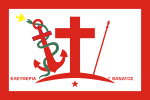 |
1821–Present | The flag of Psara, used as an ensign for ships from Psara during the Greek War of Independence, now a municipal flag. | White cloth bordered with red with a large red cross and the inscriptions of the motto Eleftheria i Thanatos (Liberty or Death) in capital red letters. The cross is standing on an upside down crescent, symbolizing the Ottoman Empire, flanked on one side by a lance, on the other by an anchor, around which is coiled a serpent eating a bird. |
 |
1821–Present | The flag of Spetses, used as an ensign for ships from Spetses during the Greek War of Independence, now a municipal flag. | |
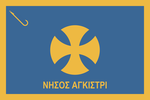
|
1821–Present | Flag of Agistri island | |
Historical flags
| Flag | Date | Use | Description |
|---|---|---|---|
 |
1863–1924 1935–1970 |
State and War flag of the Kingdom of Greece. | The flag consists of a white cross on a field of blue with a golden royal crown superimposed in the center of the cross. |
 |
1822–1970 1975–1978 |
In January 1822, the First National Assembly at Epidaurus adopted this design to replace the multitude of local revolutionary flags then in use. Since 1828, this flag was flown inside the country, while the current flag was flown on naval vessels and abroad. | White cross on a blue field. During the periods of monarchy (1833–1924 and 1935–1973), a golden crown was often added in the centre of official flags (see examples below). |

|
1955-1959 | Flag of EOKA, the Cypriot Greek nationalist guerilla organisation from the 1950s. | White cross on a blue field. The inscription reads: "Ελευθερία ή Θάνατος, Ζήτω η Ελλάς" (Freedom or Death, Long live Greece). |

|
1945–Present | Known as the Flag of Athenian Liberty, it was first hoisted on the Acropolis of Athens on the liberation of the city from Nazi occupation on 12 October 1945, a ceremony which is repeated every year on the anniversary of liberation. | The old national flag, with a depiction of the seal of the Athenian association in the centre. |

|
1919-1923 | Flag of the proposed state of the Republic of Pontus. | The naval version of the Greek flag with a black eagle superimposed in the centre of the cross in the canton. |
 |
1914 | Flag of the Autonomous Republic of Northern Epirus. It is used until today by many Northern Epirotes. | Resembles the land flag but with a black two-headed eagle in the middle. Beneath it are the Greek letters "Α" and "Η" that stand for "Αυτόνομη Ήπειρος" (Autonomous Epirus) and the year 1914, the year of its foundation. |
 |
1912 | Flag of the Free State of Ikaria. | |
 |
1834–1912 | Flag of the autonomous Principality of Samos, tributary to the Ottoman Empire. | The flag consists of the plain cross version of the Greek national flag, with the upper half field in the red of the Ottoman flag. |

|
1834–1912 | Princely flag of the autonomous Principality of Samos, tributary to the Ottoman Empire. | The flag consists of a white triangle on blue background, bearing a red Greek cross in the centre. |
 |
1898–1908 | Flag of the autonomous Cretan State. | The flag consists of the plain cross version of the Greek national flag, with the canton in red with a white five-pointed star, symbolizing Ottoman suzerainty. It was not popular during its period of official use, as Cretans wanted union with Greece, and was de facto abolished following the island's unilateral proclamation of union with Greece in September 1908. |

|
1897-1898 | Cretan revolutionary flag of the 1897 revolt. | |

|
1878-1885 | Flag of Eastern Rumelia in Northern Thrace. | Three horizontal stripes red, white and blue. |
 |
1878 | Flag of the 1878 Cretan Insurrection. | The design of the flag above is a series of 5 stripes, the blue ones only stretching to 4/5 of the flag. The banner contains the words "ΗΤΑΝ ΗΕΠΙΤΑΝ" (expression of the Spartan women, when they would send off their sons into war implying: either with this , or on this ) on the second white stripe, followed by a likely date of the rebellion, August 16, on the third white stripe. On the first two stripes, on the extreme right corner, a Greek cross is displayed. |

|
1878 | Flag of West Macedonia during the 1878 revolt. | |
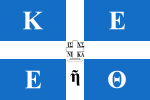 |
1866 | Flag used in the Arkadi Monastery by Christian Cretans supporting union with Greece, during the Great Cretan Revolt of 1866–1869. | The flag consists of the plain cross version of the Greek national flag, featuring the initials of the motto Κρήτη, Ένωσις, Ελευθερία ή Θάνατος ("Crete, Enosis, Freedom or Death"), and the cross with the inscription ΙΣ ΧΣ ΝΙΚΑ ("Jesus Christ Conquers"). |
 |
1817–1864 | Flag of the United States of the Ionian Islands, a British protectorate from 1815 until its unity with Greece in 1864. | The flag is a variation of the British colonial Blue Ensign, with red bordering. It is defaced with the islands' emblem, a variant of the Venetian "Lion of St. Mark" holding seven bundled arrows, representing the unity of the seven Ionian Islands, with the Bible superimposed on them. |
 |
1800–1807 | Flag of the Septinsular Republic, the first modern Greek self-governing state, comprising the Ionian Islands, under joint Russian and Ottoman suzerainty. | The flag depicts the "Lion of St. Mark", the symbol of the Republic of Venice, under whose rule the Ionian Islands were until 1797. The lion holds seven bundled arrows, representing the unity of the seven islands, with the Bible superimposed on them. |

|
1807 | Flag of captain Ioannis Stathas, designed in the island of Skiathos. It resembles the old flag and the Jack of the Hellenic Navy. | White cross on an azure field. |

|
1807 | Flag of Central Macedonia designed by chieftain Nikolaos Tsamis against the Ottoman Empire. | An azure Greek cross on a white field. The flag also bore the inscription: "Σημαία Ελληνική, Νικόλαος Τσάμης" (Greek Flag, Nikolaos Tsamis). |
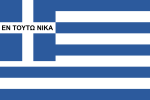
|
c.a 1800 | Flag of the Kallergis family used before the revolution. | The flag shares a lot of similarities with the current flag and bears the phrase "EN TOYTΩ NIKA" (In hoc signo vinces, eng: In this sign thou shalt conquer). Heraldic ensembles containing the Kallergis family coat of arms (bendy argent and azure) can be found all over the island of Crete, in churches and other monuments. |
 |
c.a 1793 | Flag proposed by Rigas Feraios for his envisioned pan-Balkan Federation. | Three red, white and black horizontal stripes. Red stands for the imperial purple, white for the righteousness of the fight against tyranny, and black for the death in the struggle for liberty. It also features three crosses for the Christian nations of the Balkans, and the club of Hercules in the middle. |

|
1774-? | This flag, the so-called "Graeco-Ottoman" ensign (Γραικοθωμανική παντιέρα), was allowed for use by Greek merchant ships during the latter stages of Ottoman rule. | The flag consists of three horizontal stripes in the colours red (for the Ottoman Empire), blue (for the Greeks) and red. |

|
1769–1821 | This design appeared in the 1769 uprising, based on older patterns. Used among others by the Kolokotronis family, this flag, with variations, was the most widely used throughout Greece during the initial stages of the 1821 revolution. | A blue or cyan cross over a white field. |
| Greek War of Independence | |||
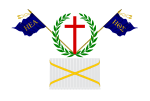 |
1814-1821 | The flag of the Filiki Eteria. | |

|
1820-1823 | Flag raised by the leader of the Souliotes, Markos Botsaris, in Souli, October 1820, after their exile in the Ionian islands. | The flag depicts St. George and reads in Greek: "Freedom", "Fatherland", "Religion". |
 |
1821–1825 | The flag of the Areopagus of Eastern Continental Greece, a regional administration during the Greek Revolution. | The flag consists of three vertical stripes in the colours green, white and black. The cross stands for Orthodox Christianity, the flaming heart for the will to fight for independence, and the anchor for the steadfastness of purpose. |
 |
1821-1829 | Flag of Greek guerrillas during the Greek War of Independence. | Horizontal tricolor of yellow, blue, and white with a wreath and cross, the motto "Ελευθερία ή Θάνατος" (Freedom or Death) is written on the bottom. |
 |
1821 | Flag of the Sacred Band. | Three red, white and black horizontal stripes with a golden phoenix rising in the middle and reads in Greek: "Εκ της κόνεώς μου αναγεννώμαι" (From my ashes I am reborn.) |
 |
1821 | Used by Athanasios Diakos and his irregulars during the Greek War of Independence. | The figure of St. George slaying the dragon, with the motto "Ελευθερία ή θάνατος" (Freedom or Death). |
 |
1821 | Flag used by Andreas Miaoulis. | |
 |
1821 | The first Greek revolutionary flag, raised at the beginning of the Greek War of Independence by Andreas Londos. | A black Latin cross in the center of a red field. |
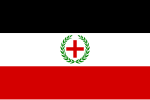 |
1821 | Used by Alexander Ypsilantis. | |
 |
1821 | Used by Anthimos Gazis and his irregulars from Thessaly during the Greek War of Independence. | |
 |
1821 | Another flag used also in Thessaly during the War of Independence, created also by Anthimos Gazis. | |
 |
1821 | Flag of the Military-Political System of Samos during the Greek War of Independence. | |
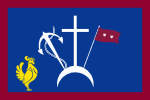 |
1821 | Flag of the revolutionaries from Chalkidiki during the Greek War of Independence. | |
 |
1821 | Flag of the revolutionaries from Thrace and Samothrace during the Greek War of Independence. | A black Greek cross on blue background |
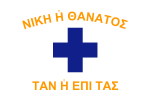 |
1821 | The flag of the fighters of the autonomous Mani Peninsula. | A blue Greek cross on white background, with the words "Victory or Death" and the ancient Spartan motto "With it or upon it" in gold. |

|
1822 | Flag of the revolutionaries from Naousa, in Macedonia during the Greek war of Independence. | Azure cross on a white field with a golden the phoenix rising from the flames. The flag bears the inscriptions: "ΕΝ ΤΟΥΤΩ ΝΙΚΑ" (In hoc signo vinces, eng: In this sign thou shalt conquer) and "ΜΑΧΟΥ ΥΠΕΡ ΠΙΣΤΕΩΣ ΚΑΙ ΠΑΤΡΙΔΟΣ" (Fight in favor of faith and fatherland) which was the title of the Declaration of the Greek Revolution by Alexander Ypsilantis. |
| Medieval | |||

|
1460-1490 | Flag used by the Greek military leader Krokodeilos Kladas in the Peloponnese during the first Ottoman-Venetian war and later during revolts in Mani and Epirus. | A black double-headed eagle on a red field. |

|
1431-1799 | The flag of Himara in Epirus during the Ottoman era. | The Archangels Michael and Gabriel depicted on a white field. |
 |
1431–1619 | The Greek sipahi cavalry units serving with the Ottoman army were allowed to use this flag during the first centuries of Ottoman rule, when within the territory of Epirus and the Peloponnese. Similar flags were used during the Greek Revolution. | A blue cross over a white field, with an image of St. George slaying the dragon in the middle. |
 |
1218–1566 | Flag of Republic of Genoa used in Genoese domains of Greece. | Saint George's flag, a red cross on white field. |
 |
1204–1797 | Flag of the Republic of Venice from the portolan chart attributed to A. Dulcert, used in Venetian domains of Greece. | The red lion of Saint Mark on a white field. |
 |
c.a 1350 | Imperial banner of the Palaiologos dynasty, as recorded by pseudo-Kodinos and one of the Byzantine flags depicted in the Castilian Conosçimiento de todos los reynos. The flag is presented as the flag "of the real Greece and Empire of the Greeks (la vera Grecia e el imperio de los griegos)". | Golden cross with four betas on red field. cf. Byzantine flags and insignia |

|
c.a 1350 | Flag of the "Empire of Constantinople" in the "Book of All Kingdoms". | A quartered flag, I and IV, white with a red cross, II and III, red with a yellow cross couped, with each of its quarters taken by yellow fire steels which are corrupted Greek Betas. |

|
c.a 1300 | The Byzantine imperial ensign (βασιλικόν φλάμουλον) of the 14th century according to Pietro Vesconte's portolan chart. cf. Byzantine flags and insignia | |

|
c.a 1300 | Banner with the double-headed eagle, used in Western portolans to mark the Empire of Trebizond in the 14th century. | Golden double-headed eagle on a red field. |

|
12th century | Examples of Byzantine military banners (bandon), according to the Madrid illuminated manuscript of John Skylitzes' chronicle. | The flags shown in the manuscript vary widely in appearance and no singular pattern can be discerned, apart from a relatively restricted range of colours (red, white, and blue) used either monochromatically or in alternating bands. Their veracity is open to question, as the Madrid manuscript was painted in 12th-century Sicily, but is supposed to represent events of the 9th–11th centuries. |

| |||

| |||

| |||
Other historical flags
| Flag | Date | Use | Description |
|---|---|---|---|
 |
1822–1828 | First flag of the Greek Merchant Navy, adopted in January 1822. In 1828 it was discontinued, as it was decided that the cross-and-stripes naval flag (today's national flag) should be flown by both military and merchant ships. | Blue flag with an inverse state flag on the canton (Blue cross on white field). |
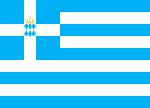 |
1833–1858 | War ensign at sea during most of the reign of King Otto, adopted in 1833. | The flag consists of the naval version of the national flag in 25:18 proportions, with the Bavarian arms of the Wittelsbach dynasty superimposed in the center of the cross, topped by a golden royal crown superimposed in the canton. The shade of blue is undefined, but was usually of a lighter shade. |
 |
1858–1862 | War ensign at sea during the late reign of King Otto, adopted in 1858. | The flag consists of the naval version of the national flag in 3:2 proportions, with the Bavarian arms of the Wittelsbach dynasty superimposed in the center of the cross, topped by a golden royal crown superimposed in the canton. The shade of blue is undefined, but was usually of a lighter shade. |
 |
1914–1924 | The flag of the Minister of Naval Affairs, adopted in 1914. | |
 |
1936–1970 | Royal version of the State Flag during the Kingdom of Greece. | The flag consists of the plain cross version of the national flag, with a detailed golden royal crown superimposed in the center of the cross. The field is bordered by a gold fringe. |
 |
1863–1924 1935–1970 |
Jack of the Royal Hellenic Navy. | A square flag with a white cross on a blue field with the Hellenic Royal Crown in the centre. The crown was added during the periods of monarchy (1833–1924 and 1935–1973). |
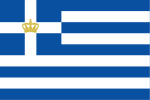 |
1863–1924 1935–1974 |
War ensign for naval vessels during the Kingdom of Greece. | The flag consists of the naval version of the national flag, with a golden royal crown superimposed in the center of the cross in the canton. |
 |
1973 |
Ensign of the Royal Hellenic Air Force until 1973. | A white cross on a blue field with the roundel of the Hellenic Air Force in the centre, the royal crown in a circle on the canton. |
 |
1973-1978 | Ensign of the Hellenic Air Force (1973–1978) and Greek Civil Air Ensign, until 1978. | A white cross on a blue field with the roundel of the Hellenic Air Force in the centre. |

|
1919-1973 | Service flag of the Hellenic Coast Guard. | The naval version of the national flag, with a golden royal crown superimposed in the centre of the cross in the canton and two silver anchors crossed in the upper left corner. |
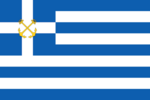
|
1973-1980 | Service flag of the Hellenic Coast Guard. | The naval version of the national flag, with two golden anchors crossed in the centre of the cross in the canton. |
Current and historical variants used outside of Greece
| Flag | Date | Use | Description |
|---|---|---|---|
 |
since 1964 | Jack of the Cypriot Navy. | A square flag with a white cross on a blue field, with a crossed anchor, trident and cross in gold superimposed. |
 |
since 1950s | Unifying flag of Cyprus (Enotiki Simaia) | Used by many Greek Cypriots until today. It represents the willing of Greek Cypriots for union with Greece (Enosis). |
Political flags
| Flag | Date | Party | Description |
|---|---|---|---|
| Current | |||
 |
2018–present | New Democracy | |
 |
2020–present | SYRIZA (Coalition of the Radical Left – Progressive Alliance) | |
 |
1974–present | Communist Party of Greece | |
 |
1940s | ||
 |
1974–present | PASOK (Panhellenic Socialist Movement) | |
 |
1973–present | Flag of the Kingdom of Greece. Today used by Greek monarchists. | |
| Former | |||
 |
1993–2020 | Golden Dawn | |
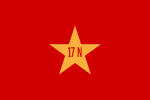 |
1975–2002 | Revolutionary Organization 17 November | |
 |
1946–1949 | Democratic Army of Greece | |
 |
1943–1950 | Organization X | |
 |
1942–1945 | ELAS | |
 |
1936-1941 | National Youth Organisation (EON) | |
 |
1932–1943 | Greek National Socialist Party | |
 |
1927–1944 | National Union of Greece | |
 |
1922-1936 | Freethinkers' Party | |
Religious flags
| Flag | Date | Use | Description |
|---|---|---|---|
 |
1980s–present | Flag of Greek Orthodox Church and the autonomous region of Mount Athos. | Black Double-headed eagle on a golden field. |
Ethnic group flags (used unofficially)
| Flag | Date | Use | Description |
|---|---|---|---|
 |
?-Present | Flag of the Greek Aromanians. | |
 |
?-Present | Flag of the Cappadocian Greeks. | Misrepresentation and misclassification of flags belonging to various subsets of Greek Nationals from specific regions. All individuals of Cappadocian, Pontic and/or Sarakatsani identity who honor those three flags have the exact same ethnic origin, as well as national identity, as Macedonians, Thracians, Epirotes, Thessalians, Cretans, Dodecanesians, Cycladites, Heptanesians, Athenians, Peloponnesians, etc. who honor one of the Regional Greek Flags depicted in the respective section above. They are all Greek people by right of birth, more than simply citizens of the Greek State. They are not ethnically distinct from the rest of the Greeks. The same may not be readily said about the Aromanians, who constitute a separate ethnic group, although they too are Greek Citizens. Furthermore, those flags are as official as the flag of Greek Macedonia. Had it not been for the loss of Greek Territory in Asia Minor, they would represent the respective Regions of the Greek State, had it included Cappadocia and Pontus. Drawing details often vary by version. |
 |
?-Present | Flag of the Pontic Greeks. | |
 |
?-Present | Flag of the Sarakatsani. |
Yacht clubs of Greece
| Flag | Club |
|---|---|

|
Burgee of Nautical Club of Palaio Faliro |
See also
References
- ^ per Royal Decree of 20 February 1936, Gazette 109, dated 26.02.1936, pages 549-550
- ^ "Royal Decree of 3 June 1914, published in ΦΕΚ 175/1914".
- ^ "ΦΕΚ 541/1935, dated 12.11.1935, page 2656".
- FLAGS AND SIGNALS OF ALL NATIONS by Hounsell Brothers c.1870 http://www.life.com/image/50700092 Archived 2011-09-09 at the Wayback Machine
- Greek National Historical Museum "ΙΣΤΟΡΙΚΗ Κ ΕΘΝΟΛΟΓΙΚΗ ΕΤΑΙΡΕΙΑ ΤΗΣ ΕΛΛΑΔΟΣ - Departments - Collections - Flags". Archived from the original on 2011-07-21. Retrieved 2011-01-16.
- ^ "Royal Decree of 28 August 1833, published in ΦΕΚ 41/1858".
- ^ "Royal Decree of 4/16 April 1833, published in ΦΕΚ 21/1833".
- Znamierowski, Alfred (2010). The World Encyclopedia of Flags. Anness Publishings. ISBN 978-1-84476-895-0.
- Eleni Kokkonis-Lambropoulos & Katerina Korres-Zografos (1997). Greek flags, arms and insignia (Ελληνικές Σημαίες, Σήματα-Εμβλήματα) (in Greek). E. Kokkonis-G. Tsiveriotis. ISBN 960-7795-01-6.
- "Η Σημαία της Απελευθέρωσης των Αθηνών". ΤΑ ΑΘΗΝΑΪΚΑ (in Greek). 2018-10-12. Retrieved 2023-08-04.
- SkiathosLife (2019-03-22). "Εδώ φτιάχτηκε η πρώτη Ελληνική Σημαία". SkiathosLife (in Greek). Retrieved 2023-02-06.
- "Royal Decree of 31 May 1914, published in ΦΕΚ 175/1914".
External links
- Kokkonis Flag Factory - Historical Flags.
- FotW: Greece
- Origin and Evolution of the Greek Flag, March 2017 (Open Access eBook)
| Greece topics | |||||||||||||||||||||||||||
|---|---|---|---|---|---|---|---|---|---|---|---|---|---|---|---|---|---|---|---|---|---|---|---|---|---|---|---|
| |||||||||||||||||||||||||||
| |||||||||||||||||||||||||||
| |||||||||||||||||||||||||||
| |||||||||||||||||||||||||||
| |||||||||||||||||||||||||||